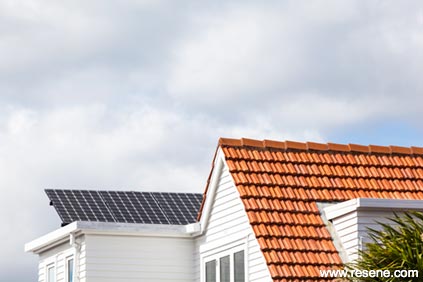
As residential electricity prices head skywards more homeowners are considering solar power as an alternative energy source.
Solar energy connections have nearly quadrupled since 2011, according to Sustainable Electricity Association of New Zealand (SEANZ) figures. Around 40 to 50 home solar power systems are installed every month. At the same time, the price of installations dropped about 36%, to an average system cost of about $10,000. The initial outlay can be offset within six to seven years.
SEANZ chairman Brendan Winitana says the biggest barrier to more homes using solar energy is the cost as well as a lack of awareness among consumers of the benefits. It’s an energy source that is gaining in recognition however.
Tapping into solar energy means that homeowners are less dependent on their electricity supplier. They can even often sell any excess energy generated back to the power companies.
It’s also an eco-friendly power source. Although the production of solar panels requires input of raw materials and energy, solar power’s environmental impact is minimal. The technology doesn’t produce carbon, methane or fossil fuel emissions. Often solar panel systems are hidden on the rooftop and the technology usually lasts longer than 20 years.
Two technologies are used to capture solar energy: solar water-heating systems and photovoltaic conversion of radiant energy to electricity. Both use panels usually attached to the roof itself or on a frame on the roof.
Photovoltaic (PV) cells, usually made of silicon, are designed to generate an electric current when exposed to sunlight. New Zealand receives on average about four kilowatt hours of raw solar energy per day for each horizontal square metre. Solar electric PV panels can convert up to 15% of the available solar energy into electricity; the percentage converted is lower because of the sun’s changing position in relation to the fixed panels.
The average household uses about 22 kilowatt hours of electricity per day which requires about 45 square metres of PV panels on the roof. The average roof has much more area than that, so this is easily achievable.
The cost of solar panels has fallen significantly in recent years as production expands and technologies improve. However installation and related equipment needed, such as a battery bank (if required), add to the cost.
International Energy Agency figures predict that 11% of all the world’s power will be generated by photovoltaic panels by 2030.
Solar water heating uses the sun’s rays via collection panels to heat water, which is then stored in an insulated hot water cylinder. Well-designed and installed solar water heating systems will meet 50- 75% of a home’s hot water needs.
When the sun can’t heat enough water to meet a property’s needs, an electric, gas or other booster can be installed. Upfront costs are high compared to other hot water systems, but once installed they provide free energy and reduce overall water heating costs.
Most homeowners installing solar panels want to reduce their power bills and protect themselves from power price hikes. As well, solar is a sustainable energy choice so there is definitely a feel-good factor.
One happy customer of Harrisons Home Energy Solutions recently installed a 4.680 kWp Solar System, comprising a 5kw inverter and 18 x 260 mono x panels (nine facing north and nine facing north-east). Living in Auckland, he generated an average of 20kW per day in January. That equates to a saving of around $174 for the month (29c per kW inclusive of GST).
Search habitat magazine stories
Printed copies of habitat highlights are available from late March 2024 at Resene ColorShops and resellers, while stocks last. You can view back issues of habitat magazine online.
Specifiers:
If you have an idea, project or story that you think would suit habitat, we’d love to hear from you. Please drop us an email with your details and include photos if submitting a project.
Sign up for a DIY card and Save! Australia | New Zealand